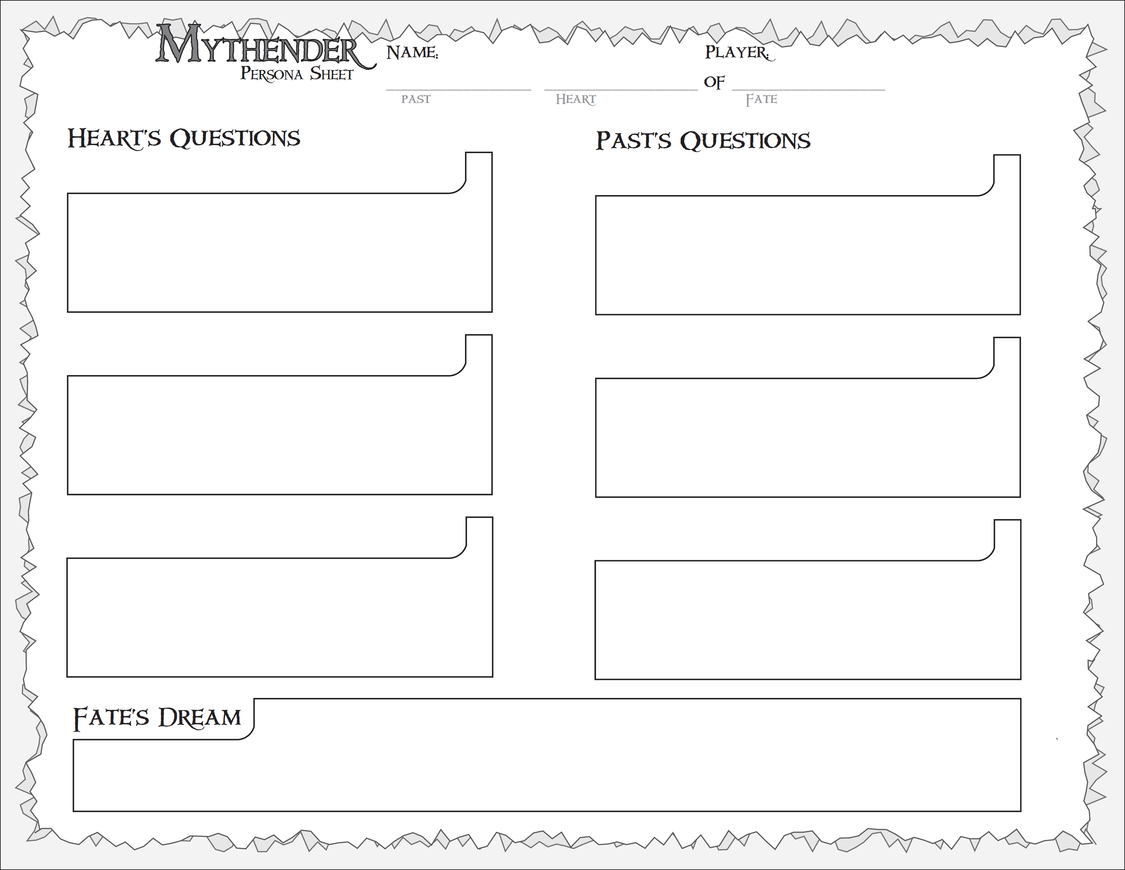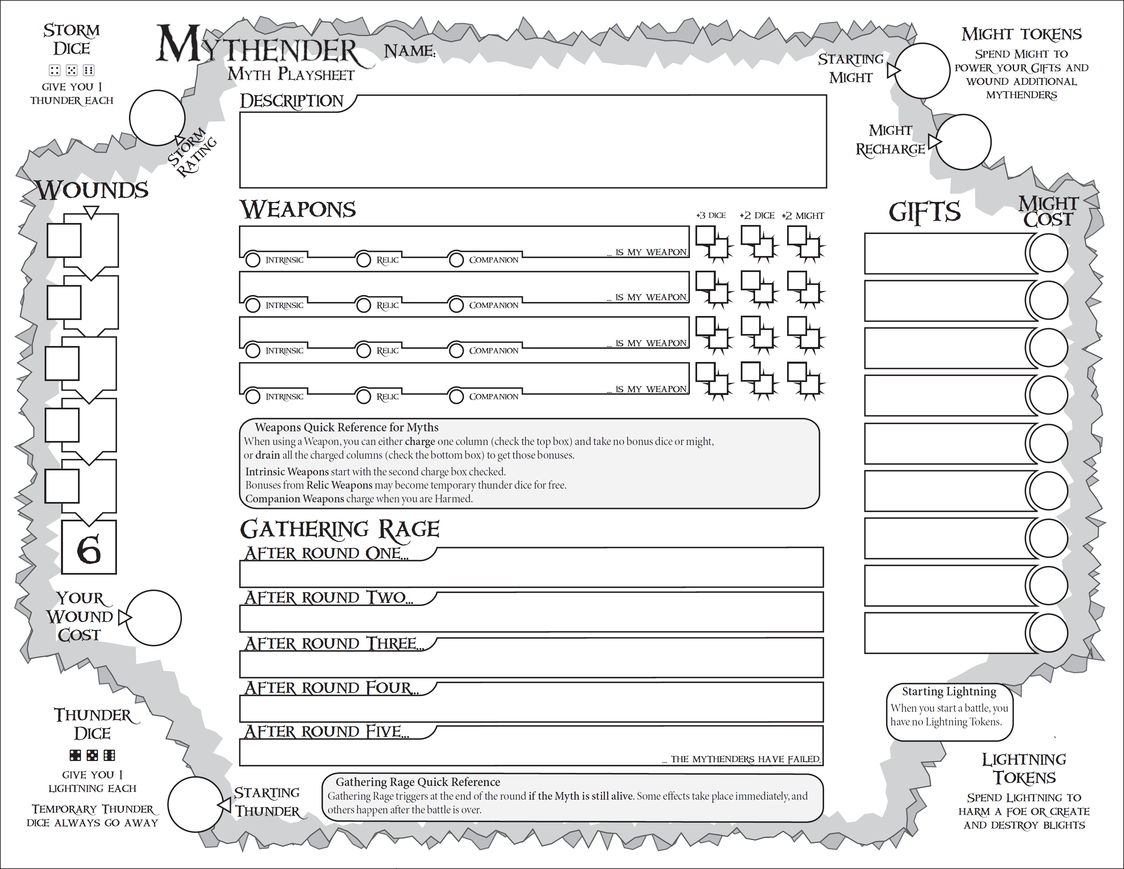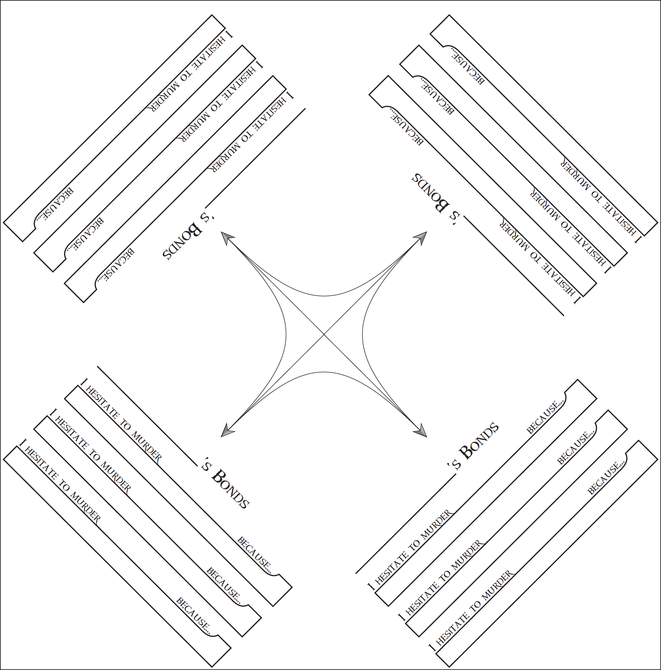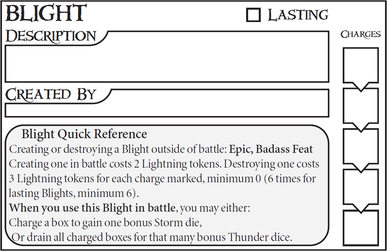WHAT YOU NEED TO PLAY
PLAYERS & CHARACTERS
Players
Mythender takes four to five players: three to four playing the roles of Mythenders, and one playing the role of the Mythmaster—the person who will play out the Mythic World and everyone else inside it. (The rules for being a Mythmaster are found in the Being a Mythmaster chapter.)
This game does not work well for more than four Mythenders. And by “not work well” I mean “you will have a horrible time.”
For variants allowing for fewer Mythenders, here.
Characters
Each person playing a Mythender will need a Mythender created, either fresh or a pre- generated Mythender. The Mythmaster will need some Myths ready to be Ended, and a list of names for mortals encountered.
If you’re playing in Mythic Norden, the stuff for the Mythmaster is already made in the that chapter.
The Table
This game requires you to use playsheets—paper that you’ll put dice and tokens on, and write on and erase throughout play.You’ll need a flat surface for each person. In addition, the dice and tokens are communal; all the players, including the Mythmaster, share them as they gain and lose things. So, this game is best played around a table where everyone can reach things and have enough surface area for their playsheets.
Hands
This game requires hands. That might be weird to say, but it’s important to note because Mythender uses tactile experiences to enhance play—holding a fistful of dice is fun!
While you’re always free to play this over voice chat services and online die rollers, you might find the game lesser fun than if you’re holding your Mythender’s ultimate might in your very hands. Plus, an online die roller will probably be a pain in the ass to constantly tweak for your constantly changing multi-colored die pools.
Fair Warning!
Mythender has quite a few moving parts! Don’t worry, each one has a space on the playsheets (see below) to help you play the game. Using all this is explained later in the rules. For now, you should just know what materials you’ll need for play.
DICE & Tokens
All the many dice of Mythender are six-sided dice.You’ll need four different sorts of dice: three of them should be smaller dice, of three different colors; one type should be larger and heavier.
Storm Dice
Storm dice are represented by white dice: 1 2 3 4 5 6. You’ll need 30-40 in order for everyone to hold onto their dice. If you have fewer, you can share, but you may need as many as 15 at any given point.
Thunder Dice
Thunder dice are represented by black dice: 1 2 3 4 5 6. You’ll need at least a hundred for the group, the more the better. Holding onto your own Thunder dice is a key part of the game. If you run out of Thunder dice, use some sort of counter to keep track of how many you have, as it constantly changes with every turn.
Bonus Dice
Bonus Thunder dice are represented by red dice: 1 2 3 4 5 6. You’ll only need ten or twelve for the group, as they aren’t held onto when a turn is over.
There are times when you’ll also get bonus Storm dice, but for those you’ll use the same white dice as normal Storm. Thunder is kept track of from one moment to the next.
The Mythic Die
The Mythic die is represented by a larger die than all the others: 6. Having one die is enough, though if each Mythender has their own Mythic die, all the better.
Lightning Tokens
Lightning is represented by tokens. You’ll need at least a hundred, though it’s easy to do if you have some that represent 1 Lightning and some that represent 10 Lightning. Plastic crystals that are sold in many hobby stores are cheap and come in different sizes. And they look a little like captured lightning, with the right imagination.
Might Tokens
Might is also represented by tokens. You’ll need around 70, though you can make that easier by splitting them up into denominations of 1 and 5. Metal coins make great Might tokens— pennies and nickels and easy to get, or get some fancy metal gaming coins.
Holy Crap! That’s a Lot of Stuff!
If that’s too many dice for you, go and have fun with a different game. No hard feelings; no game is for everyone. But if you want to embrace rolling fistfuls of dice while shouting “I’MMA KILL YOUR FACE ODIN!” then you’ve come to the right place.
Material Suggestions
12mm dice are great for Storm, Thunder, and bonus Thunder dice. You might be rolling 40 dice during later actions, so have dice that fit in your hands. Have something at least twice as large or heavy for Mythic dice. My favorite are stone dice from the Smithsonian Natural History Museum.
MYTHENDER PLAYSHEETS
Each person playing a Mythender needs a Mythender playsheet. It’s called a playsheet because you’ll set it on the table and play on it, like a little paper board or place mat.
The game has a number of moving parts that constantly change during every turn, requiring you to grab or put back different dice and tokens, as well as remember how many you have at any given time. The corners give you a place to put these dice and tokens so that you remember what they’re called while playing the game.
You’ll also need to check boxes and occasionally erase the checks, as you gain and lose things over the course of an adventure. So make sure you’re using pencil while playing.
You’ll fill in the sheet in Creating Your Mythender. The sheet has a few quick reference boxes, so that you don’t have to keep looking up basic options.

Parts of the Playsheet
How each of these parts work are covered in chapters to come, but here are the basics:
Name: at the top, you’ll write your character’s name, your name as the player, and the Past, Heart, and Fate chosen during Mythender creation.
Dice & Tokens: on each corner is a space for you to keep your Storm dice, Thunder dice, Lightning tokens, and Might tokens separate. There are quick references to remind you how they work.
Wounds: here’s where you’ll keep track of when you’re Wounded in battle, and your Wound Cost, which is always 3 for Mythenders.
Weapons: these are your three Weapons, used in battle against Myths. They charge and drain as you fight.
Mythic Corruption & Forms: these are your telltale signs of corruption.Your Mortal Form is how you look normally. The Personal Blight is the effect you constantly have around you. Your Paragon, Supernatural, and Godly Forms are what you become as you check the Corruption boxes to the left of them. And your Fate’s Power is the thing that your Mythic Heart allows you to do.
Fate: to the far right, this track shows how much mortality you’ve lost and how close you are to becoming a god. If you check far enough down to the boxes with numbers, you’ll have to roll a die at the end of a battle to see if you become a god.
The first one is permanent, so it is star red to let you know that you cannot lose it.
Gifts: next to each line on the track is a slot for a Gift. Gifts change how the rules work for you in a battle, and most require you to spend Might tokens to use.
Numbers: the numbers next to your Forms are Corruption numbers, and on the Fate track are Apotheosis numbers. These show how close to becoming a Myth you are.
MYTHENDER PERSONA SHEETS
Each person playing a Mythender may also get a Persona Sheet. You’ll use this during Mythender creation to answer the questions about your character.
Name: this is the same as on the playsheet.
Heart’s Questions: the Heart you pick will have three questions. Here, you’ll write down the questions and their answers.
Past’s Questions: the Past you pick will also have three questions. As with Hearts, you’ll write down the questions and their answers.
Fate’s Dream: the Fate you pick will haunt you every night with a dream of the god you’re destined to become. Here, you’ll write that dream down.
Note: if you’re doing quick Mythender creation, you won’t need this sheet. It’s there for when you can take the time to fully flesh out your Mythender’s background, motivations, and nature.

MYTH PLAYSHEETS
As the Mythmaster, you’ll need a Myth Playsheet for each foe the characters will face. These are similar to the Mythender playsheets, so that you and the other players use the same sort of setup during battle.
Each Myth has a different set of stats and Weapons. The Myths for Mythic Norden are detailed in their own chapter. There’s advice for making your own Myths in the Mythmaster’s chapter.

Parts of the Playsheet
How each of these parts work are covered in chapters to come, but here are the basics:
Name & Description: at the top, you’ll write the Myth’s name or title and its description.
Dice & Tokens: on each corner is a space for you to keep the Myth’s Storm dice, Thunder dice, Lightning tokens, and Might tokens separate. There’s also a quick reference to remind you how they work.
The Storm rating, starting Thunder and Might, and Might recharge vary for each Myth. Note that Myths have a Might Recharge section and Mythenders don’t.
Wounds: here’s where you’ll keep track of when the Myth is Wounded in battle, and its Wound Cost, which varies for each Myth.
The Wound cost, number of boxes, and their corresponding Wound numbers vary for each Myth.
Weapons: these are the Myth’s Weapons, used in battle against Mythenders.
Lesser Myths only have three Weapons. Gods and Greater Myths have four, and have some Weapons more powerful than others.
Gathering Rage: different effects are triggered at the end of each round, if the Myth is still alive. Battles always end after five rounds; if they last that long, the Mythenders have given the Myth too much time.
Gifts: as with Mythenders, Gifts allow the Myth to change how the rules work for them in a battle, and most require spending Might tokens to trigger. Lesser Myths have three or four Gifts, while Greater Myths have more.
Lesser Myths & the Myth Playsheet
Since Lesser Myths have fewer Wound boxes, Weapons, and Gifts, when you’re making a sheet for one, cross out what you’re not using, so it’s clear to everyone.
BONDS SHEETS
Mythenders are bonded to one another through how they feel…or, more importantly, why they don’t either walk away from or murder each other. These are represented by their Bonds. These Bonds are recorded on the group’s Bonds Sheet.
The group shares one Bonds sheet, as a symbol that they are together to End Myths. During Mythender creation, you’ll come up with these bonds. In case you’re wondering how these might be used in play, they’re used when you decide to break these Bonds by Murdering Another Mythender (page 184).

BLIGHT CARDS & OTHER THINGS
Blight Cards
Another part of Mythender are Blights, Mythic scars on the land that continually gushes power (see Blights). Both Mythenders and Myths create, manipulate, and destroy Blights. These are recorded on Blight Cards.
Unlike playsheets, you don’t put dice or tokens on these cards. They’re meant to be handed around as they’re used and ripped up when destroyed. You can easily make rough versions of these with index cards or pieces of paper.

Parts of the Card
Description: here you’ll write what the Blight looks like.
Created by: write who created this Blight, as a Myth’s Blight can only be used by a Myth, and a Mythender’s Blight can only be used by that or another Mythender.
Lasting: you’ll mark if this Blight is persistent; otherwise, it goes away after a Battle.
Charges: as the Blight is used, it will be charged and drained.
Other Things
You may want to use paper for other bits, like recording the names of mortals that the Mythenders don’t just immediately slaughter.
References
You might want to print out and have handy the following:
- Creating Your Mythender (useful as a quick reference)
- Battle in Brief
- Moments in Brief
- Your Heart’s Gifts
- Tutorial Battle
- Mythenders’ Powers & Burdens
- Mythmaster Key Techniques, pages 250–251
You can download all these at MythenderRPG.com.